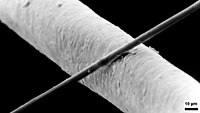
Photo from wikipedia
OBJECTIVE The aim of this study was to evaluate the fracture-behavior of direct composite restorations made with two different composite-core materials. In addition, fracture toughness (FT), flexural strength (FS) and… Click to show full abstract
OBJECTIVE The aim of this study was to evaluate the fracture-behavior of direct composite restorations made with two different composite-core materials. In addition, fracture toughness (FT), flexural strength (FS) and flexural modulus (FM) of tested composites were evaluated. METHODS Twenty groups of posterior crown restorations were fabricated (n = 6/group). The groups were made of a 4-5 mm layer of composite-core materials (everX Flow and SDR Flow+) and covered by a 2 mm layer of conventional composite (G-aenial Anterior & Posterior, G-aenial Universal Injectable, Essentia, CeramX, Filtek Z500). Control groups were only made of conventional composites or composite-core materials. Crowns were statically loaded until fracture. Failure-modes were then visually examined. FT, FS and FM were determined for each tested composite (n = 6). RESULTS ANOVA revealed that crown restorations made only from everX Flow composite had significantly higher load-bearing capacities (3866 ± 263 N) (p < 0.05) among all the groups tested. No statistically significant differences were found in the load-bearing capacities between crowns made with different composite-core materials (p > 0.05). everX Flow exhibited the highest FT (2.8 MPa m1/2) and Z500 presented the highest FS values (197 MPa) (p < 0.05) among tested composites. With regard to the failure-mode analysis, crowns that had a fiber-reinforced core material of everX Flow revealed delaminating of surface conventional composite from the substructure layer. While in crowns that had a core material of SDR Flow+ or having only conventional composites with no fiber reinforcement, showed a crushing fracture pattern. CONCLUSION Restorations combining a fiber-reinforced composite core and a surface layer of conventional composite, displayed promising performance related to fracture-behavior.
Journal Title: Journal of the mechanical behavior of biomedical materials
Year Published: 2019
Link to full text (if available)
Share on Social Media: Sign Up to like & get
recommendations!